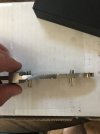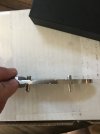- Joined
- Jul 5, 2018
- Messages
- 105
so I want to get into the world of making knives. I felt like a good starting position would be a knife kit from knifekits.com
I got it in today and it was a decent blank. I had to round some edges symmetrically and flatten some parts to match side to side. I expected as much buying a $30 kit. I also did my first go at filing the spine which I feel was decent!
However here is my question....the pins that came with it are super wobbly in the fit. There is no snugness at all between the pins and the metal. Is this how it’s supposed to be? Or are my pins to small? I’m not sure how to drill the holes through the scales if there’s that much play in the pins. I attached pictures to show how much they can move


I got it in today and it was a decent blank. I had to round some edges symmetrically and flatten some parts to match side to side. I expected as much buying a $30 kit. I also did my first go at filing the spine which I feel was decent!
However here is my question....the pins that came with it are super wobbly in the fit. There is no snugness at all between the pins and the metal. Is this how it’s supposed to be? Or are my pins to small? I’m not sure how to drill the holes through the scales if there’s that much play in the pins. I attached pictures to show how much they can move








